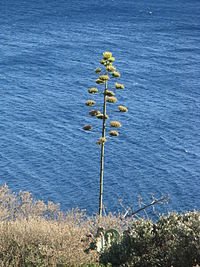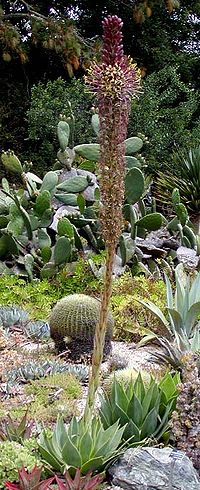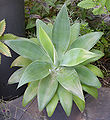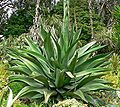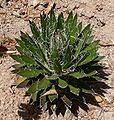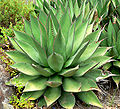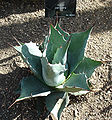- Agave
-
Agave 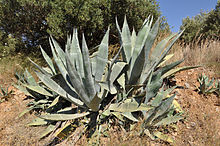
Agave americana Scientific classification 
Kingdom: Plantae clade: Angiosperms clade: Monocots Order: Asparagales Family: Asparagaceae Subfamily: Agavoideae Genus: Agave
L.Species See text. See also full listing.
Agave (pronounced /əˈɡɑːveɪ/[1] or /əˈɡeɪviː/[2]) is a genus of monocots. The plants are perennial, but each rosette flowers once and then dies (see semelparity); they are commonly known as the century plant.[3]
In the APG III system, the genus is placed in the subfamily Agavoideae of the broadly circumscribed family Asparagaceae.[4] Some authors prefer to place it in the segregate family Agavaceae. Traditionally, it was circumscribed to comprise about 166 species, but it is now usually understood to have about 208 species.[5]
Contents
Description
Chiefly Mexican, agaves are also native to the southern and western United States and central and tropical South America. They are succulents with a large rosette of thick fleshy leaves, each ending generally in a sharp point and with a spiny margin; the stout stem is usually short, the leaves apparently springing from the root. Along with plants from the related genus Yucca, various Agave species are popular ornamental plants.
Each rosette is monocarpic and grows slowly to flower only once. During flowering, a tall stem or "mast" grows from the center of the leaf rosette and bears a large number of shortly tubular flowers. After development of fruit, the original plant dies, but suckers are frequently produced from the base of the stem, which become new plants.
It is a common misconception that agaves are cacti. They are not related to cacti, nor are they closely related to Aloe whose leaves are similar in appearance.
Agave species are used as food plants by the larvae of some Lepidoptera (butterfly and moth) species including Batrachedra striolata, which has been recorded on A shawii.
Taxonomy
In the Cronquist system and others, Agave was placed in the family Liliaceae, but phylogenetic analyses of DNA sequences later showed that it did not belong there.[6] In the APG II system, Agave was placed in the family Agavaceae. When this system was superseded by the APG III system in 2009, Agavaceae was subsumed into the expanded family Asparagaceae, and Agave was treated as one of 18 genera in the subfamily Agavoideae.[4]
Agave had long been treated as a genus of about 166 species, but it is now known that this concept of Agave is paraphyletic over the genera Manfreda, Polianthes, and Prochnyanthes. These genera are now combined with Agave as Agave sensu lato, which contains about 208 species. In some of the older classifications, Agave was divided into two subgenera, Agave and Littaea, based on the form of the inflorescence. These two subgenera are probably not monophyletic.[6]
Agaves have long presented special difficulties for taxonomy; variations within a species may be considerable, and a number of named species are of unknown origin and may just be variants of original wild species.
Spanish and Portuguese explorers probably brought agave plants back to Europe with them, but the plants became popular in Europe during the 19th century, when many types were imported by collectors. Some have been continuously propagated by offset since then, and do not consistently resemble any species known in the wild, although this may simply be due to the differences in growing conditions in Europe.
Commonly grown species
The most commonly grown species include Agave americana, Agave angustifolia, Agave tequilana, and Agave attenuata.
Agave americana
One of the most familiar species is Agave americana, a native of tropical America. Common names include century plant, maguey (in Mexico), or American aloe (it is not, however, closely related to the genus Aloe). The name "century plant" refers to the long time the plant takes to flower. The number of years before flowering occurs depends on the vigor of the individual plant, the richness of the soil and the climate; during these years the plant is storing in its fleshy leaves the nourishment required for the effort of flowering.
Agave americana, century plant, was introduced into Europe about the middle of the 16th century, and is now widely cultivated as an ornamental; in the variegated forms, the leaf has a white or yellow marginal or central stripe. As the leaves unfold from the center of the rosette, the impression of the marginal spines is conspicuous on the still erect younger leaves. The plants require protection from frost. They mature very slowly and die after flowering, but are easily propagated by the offsets from the base of the stem.
Blue A. americana occur in abundance in the Karoo, and arid highland regions of South Africa. Introduced by the British settlers in 1820, the plant was originally cultivated and used as emergency feed for livestock.[citation needed] Today it is used mainly for the production of syrup and sugar.
Agave attenuata
A. attenuata is a native of central Mexico and is uncommon in its natural habitat. Unlike most species of Agave, A. attenuata has a curved flower spike from which it derives one of its numerous common names - the foxtail agave. A. attenuata is also commonly grown as a garden plant. Unlike many agaves, A. attenuata has no teeth or terminal spines, making it an ideal plant for areas adjacent to footpaths. Like all agaves, A. attenuata is a succulent and requires little water or maintenance once established.
Agave tequilana
Main article: Agave tequilanaAgave azul (blue agave) is used in the production of tequila.
Uses
The ethnobotany of the agave was eloquently described by William H. Prescott in 1843:[7]
But the miracle of nature was the great Mexican aloe, or maguey, whose clustering pyramids of flowers, towering above their dark coronals of leaves, were seen sprinkled over many a broad acre of the table-land. As we have already noticed its bruised leaves afforded a paste from which paper was manufactured, its juice was fermented into an intoxicating beverage, pulque, of which to the natives, to this day, are extremely fond; its leaves further supplied an impenetrable thatch for the more humble dwellings; thread, of which coarse stuffs were made, and strong cords, were drawn from its tough and twisted fibers; pins and needles were made from the thorns at the extremity of its leaves; and the root, when properly cooked, was converted into a palatable and nutritious food. The agave, in short, was meat, drink, clothing, and writing materials for the Aztec! Surely, never did Nature enclose in so compact a form so many of the elements of human comfort and civilization!
There are four major parts of the agave that are edible: the flowers, the leaves, the stalks or basal rosettes, and the sap (called aguamiel—honey water). (Davidson 1999)
Each agave plant will produce several pounds of edible flowers during its final season. The stalks, which are ready during the summer, before the blossom, weigh several pounds each. Roasted, they are sweet and can be chewed to extract the aguamiel, like sugarcane. When dried out, the stalks can be used to make didgeridoos. The leaves may be collected in winter and spring, when the plants are rich in sap, for eating. The leaves of several species also yield fiber: for instance, Agave rigida var. sisalana, sisal hemp, Agave decipiens, false sisal hemp. Agave americana is the source of pita fiber, and is used as a fiber plant in Mexico, the West Indies and southern Europe.
During the development of the inflorescence, there is a rush of sap to the base of the young flower stalk. Agave nectar (also called agave syrup), a sweetener derived from the sap, is used as an alternative to sugar in cooking and it can be added to breakfast cereals as a binding agent.[8] In the case of A. americana and other species, this is used in Mexico and Mesoamerica in the production of the beverage pulque. The flower shoot is cut out and the sap collected and subsequently fermented. By distillation, a spirit called mezcal is prepared; one of the best-known forms of mezcal is tequila. In 2001, the Mexican Government and European Union agreed upon the classification of tequila and its categories. All 100% blue agave tequila must be made from the Weber blue agave plant, to rigorous specifications and only in certain Mexican states.
People have found a few other uses of the plant aside from its several uses as food. When dried and cut in slices, the flowering stem forms natural razor strops, and the expressed juice of the leaves will lather in water like soap. The natives of Mexico used the agave to make pens, nails and needles, as well as string to sew and make weavings. Leaf tea or tincture taken orally is used to treat constipation and excess gas. It is also used as a diuretic. Root tea or tincture is taken orally to treat arthritic joints.[9] Several agave species are also considered to have potential as effective bioenergy crops.[10] Agave's ability to grow in naturally water-limited environments could help to prevent the food vs fuel trade-off.[11]
Warnings
The juice from many species of agave can cause acute contact dermatitis. It will produce reddening and blistering lasting one to two weeks. Episodes of itching may recur up to a year thereafter, even though there is no longer a visible rash. Irritation is, in part, caused by calcium oxalate raphides. Dried parts of the plants can be handled with bare hands with little or no effect. If the skin is pierced deeply enough by the needle-like ends of the leaf from a vigorously growing plant, this can also cause blood vessels in the surrounding area to erupt and an area some 6–7 cm across appear to be bruised. This may last up to two to three weeks.
Images of species and cultivars
-
Agave americana var. americana
-
Agave americana 'Marginata'
-
Agave americana cv. 'Mediopicta Alba'
-
Agave angustifolia 'Marginata'
-
Agave bracteosa (Spider agave)
Species
See also
Agave nectar
References
- ^ An Anglo-Hispanic pronunciation. Sunset Western Garden Book, 1995:606–607.
- ^ An Anglo-Latin pronunciation. OED: "Agave".
- ^ Bailey, L.H.; Bailey, E.Z.; the staff of the Liberty Hyde Bailey Hortorium. 1976. Hortus third: A concise dictionary of plants cultivated in the United States and Canada. Macmillan, New York.
- ^ a b Mark W. Chase, James L. Reveal, and Michael F. Fay. 2009. "A subfamilial classification for the expanded asparagalean families Amaryllidaceae, Asparagaceae, and Xanthorrhoeaceae". Botanical Journal of the Linnean Society 161(2):132-136.
- ^ Sara V. Good-Avila, Valeria Souza, Brandon S. Gaut, and Luis E. Eguiarte. 2006. "Timing and rate of speciation in Agave (Agavaceae)". PNAS (Proceedings of the National Academy of Sciences, USA) 103(24):9124-9129. doi:10.1073/pnas.0603312103
- ^ a b David J. Bogler, J. Chris Pires, and Javier Francisco-Ortega. 2006. "Phylogeny of Agavaceae based on ndhF, rbcL, and ITS sequences: Implications of molecular data for classification". Aliso 22(Monocots: Comparative Biology and Evolution):313-328.
- ^ William H. Prescott,1843 (1979 reprint). History of the Conquest of Mexico and the Conquest of Peru, Modern Library, pp. 79-80
- ^ Chomka, Stefan (30 July 2007). "Dorset Cereals". The Grocer (Crawley, England: William Reed Business Media). http://www.thegrocer.co.uk/articles.aspx?page=independentarticle&ID=120966. Retrieved 16 January 2011.
- ^ Botany in a Day, Thomas J Elpel, Hops Press LLc, p. 190
- ^ Davis, S. C.; Griffiths, H.; Holtum, J.; Saavedra, A. L. �; Long, S. P. (2011). "The Evaluation of Feedstocks in GCBB Continues with a Special Issue on Agave for Bioenergy". GCB Bioenergy 3: 1. doi:10.1111/j.1757-1707.2010.01085.x. free summary: Wiley - Blackwell (2011, January 26). Agave fuels excitement as a bioenergy crop. ScienceDaily. Retrieved January 26, 2011, from http://www.sciencedaily.com/releases/2011/01/110126121102.htm
- ^ Yan, X.; Tan, D. K. Y.; Inderwildi, O. R.; Smith, J. A. C.; King, D. A. (2011). "Life cycle energy and greenhouse gas analysis for agave-derived bioethanol". Energy & Environmental Science. doi:10.1039/C1EE01107C.
Bibliography
- Howard Scott Gentry, Agaves of Continental North America (University of Arizona Press, 1982), the standard work, with accounts of 136 species.
- Die Agaven.
- IPNI : The International Plant Name Index.
- Native Plant Information Network More information on species in the Agave genus.
- Xeric World An online community dedicated to the study of Xeric plant species with a focus on the family Agavaceae.
- Kolendo, Jan. The Agave Pages. [1]
- Davidson, Alan (1999). The Oxford Companion to Food. Oxford: Oxford University press. pp. xx + 892. ISBN 0-19-211579-0.
Categories:- Agave
- Asparagaceae genera
- Crops originating from the Americas
- Poisonous plants
- Invasive plant species in South Africa
- Flora of Pakistan
- Our Lady of Guadalupe
-
Wikimedia Foundation. 2010.


